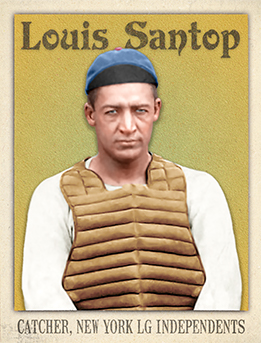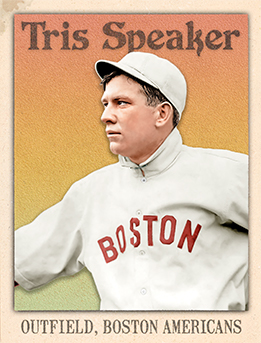- Series: Diamond Heads '15
- City: New York
- Team: Lincoln Giants
- League: Independent
- Hall: National Baseball Hall of Fame
Louis Santop (Loftin) (1890-1942) was a prodigious HR slugger & indomitable catcher in the Negro Leagues. He averaged .406 lifetime, caught two of the hardest throwing pitchers of all-time (Smokey Joe Williams & Dick Redding) and endured behind the plate for an astonishing 15 seasons despite the privations and rigor of black baseball in America in his day. A jovial giant, Top was a fan favorite & sure-fire draw with his ability to throw a ball over outfield fences before games & hit it even further during games.
- It is told the Newark park had an ad promising a suit to players who hit the 440’ centerfield fence. The sign was removed after Santop hit it three times in one game
- Played for great Negro League teams including the NY Lincoln Giants and the Hilldale Club
- Elected to Hall of Fame: 2006

- Series: Diamond Heads '15
- City: Washington, D.C.
- Team: Senators
- League: American League
Herman A. Schaefer (1876-1919) was the Clown Prince of baseball for nearly two decades in the early years of the last century. “Germany” (or “Liberty” as he thought a better nickname after WWI began) was beloved for his antics on the field. In its obituary, the New York Times said he was “one of the most popular figures on the diamond.” Born into the tough German immigrant district of south Chicago, the stocky Schaefer came up through semi-pro ball and soon made it to the Cubs in late 1901. A slump the following year sent him to the PCL and other minor league teams before the Tigers brought him back to the bigs in '05. Legends surrounded the colorful Schaefer and it is hard to tell fact from fiction. He was said to have called shots long before the Babe, make dramatic self-narrated trips around the bases and harangue mercilessly some of the greats of his day. One of his most storied feats involved his famed steal of first, accomplished from second base in order to tempt a run-scoring errant throw. After his death, baseball officially outlawed such depredations. John McGraw hired Schaefer as a scout in 1919 but the bantam joker succumbed to a TB-induced hemorrhage on a train trip to check on NY talent.
- Germany played for six MLB teams including the Federal League's Newark Peppers. He closed his career with Cleveland months before his untimely death
- His lifetime .257 average belied his ability to deliver clutch hits, seemingly at will, when the moment was right
- A Detroit sportswriter effused: “Germany Schaefer was the soul of baseball itself, with all its sorrows and joys, the born troubadour of the game.”
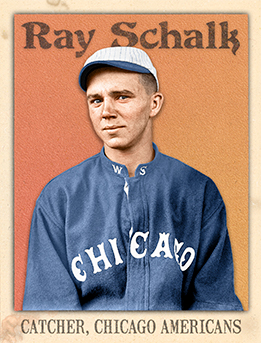
- Series: Diamond Heads '15
- City: Chicago
- Team: White Sox
- League: American League
- Hall: National Baseball Hall of Fame
Raymond William Schalk (1892-1970) was too boyish and too small for the cop at Comiskey Park to believe he could be a ballplayer. But what Schalk lacked in physical stature he more than made up in energy, determination and innate talent. He redefined the role of the ML catcher, starring for the White Sox from 1912 through 1928 en route to the Hall of Fame. Along the way, Schalk proved that catchers can steal bases, they can make double-plays, they can back-up at every base. And Schalk didn’t merely field his position better than the others of his era, he had a gift for working with pitchers. He caught four no-hitters including a 1922 perfect game. And he knew something was wrong when his best mates wouldn’t throw what he called for in the ’19 Series. Absolved of any complicity, Schalk went on to be player-manager of the team.
- Still holds records at his position, including 11 straight years catching over 100 games
- Only Yogi Berra and Carlton Fisk caught more shut-outs
- Elected to Hall of Fame: 1955

- Series: Diamond Heads '15
- City: Chicago
- Team: Cubs
- League: National League
Frank M. Schulte (1882-1949) played for his local minor league franchise, the New York State League’s Syracuse Stars, for three years before being discovered by the National League’s Chicago club, who bought his contract and brought him up at the end of the 1904 season. The team was being called the “Cubs” by sportswriters, a name that wouldn’t be official until 1907. By any name, “Wildfire” Schulte made a big impact. He was a solid-hitting outfielder who became a mainstay in West Side Park's outfield as the Cubs won four pennants and two World Series during his long tenure. Frank must have really liked the play “Wildfire” he once saw in Mississippi: He named his racehorse after the play and would earn the sobriquet for himself by teammates who clearly appreciated his spirit.
Schulte’s above average hitting (career 115 OPS+) was reliable, but he proved particularly clutch in the post-season, where he averaged .321 across 21 World Series' contests. Such fortuitous timing would further Schulte's legacy in yet another remarkable achievement: his spectacular campaign of 1911 just-so-happened to coincide with the inaugural presentation of the Chalmers Award; essentially MLB's very first MVP award, which was gifted to the "most important and useful player to the club and to the league." The prior season, Hugh Chalmers decided to spark car sales for his automotive company by offering a new model to the players with the highest batting averages in each league. The ensuing fiasco involving Ty Cobb and Nap Lajoie prompted Chalmers to revise the award in 1911 to be gifted to the leagues' “MVPs” and Schulte's career year-for-the-ages couldn't have been better timed.
Schulte’s 1911 MVP Award season:
- 154 games, 105 runs, 173 hits, 30 doubles, 21 triples, league-leading 21 HR, 107 RBI, 23 stolen bases, league-leading .534 slugging, league-leading OPS+ 156, league-leading 308 total bases
- With the performance, Schulte became the first person in MLB history to have 20 or more doubles, triples, home runs and stolen bases in the same season
- Schulte's achievement would stand unmatched for 46 years, until Willie Mays duplicated the feat in 1957
- Schulte earned his nickname by a ferocious approach to base running that saw him steal home 22 times
- Famed shortstop Joe Tinker’s Chicago career spanned Wildfire’s and Schulte inspired Tinker to speculate that no “quainter or more original character ever existed in the National Pastime.” One eccentricity was Schulte’s penchant for scouring the sidewalks looking for hairpins, auguring success at the plate.
- Another testimony to Frank’s batting prowess was his thirteen-game hit streak during his four World Series appearances, which still ranks him fourth all-time, tied with Harry Hooper and Derek Jeter
- Schulte closed out his time in Chicago with the 1916 season. He spent the next three years with three teams and went on to play in the International League and Pacific Coast League through 1922 before retiring to live in Oakland, CA
For a brief but wonderful account of the history of the Chalmers Award, including a review of the events of 1910 surrounding the controversy between Ty Cobb & Nap Lajoie, check out this Ars Longa guest blog post by Van Nightingale: Did They Get it Right?
- This card is not included in the 100-card Diamond Heads '15 base set.
- This card is one of the rewards you receive for completing the Ars Longa Clubhouse Challenge: Chalmers Awards Winners
- This card is exclusive to that challenge, is gifted freely to winners of the challenge, and is neither bartered nor sold otherwise by Ars Longa.
- This is one of two such Diamond Heads '15 Clubhouse Challenge reward cards. The other is Franklin Pierce Adams.
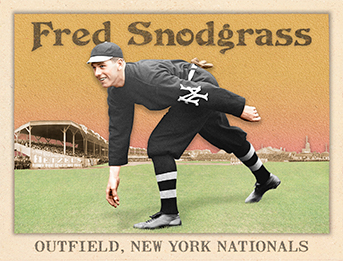
- Series: Diamond Heads '15
- City: New York
- Team: Giants
- League: National League
Frederick Carlisle Snodgrass (1887-1974) broke into MLB with the Giants in ’08 and became a mainstay in the outfield by virtue of his speed & hitting. As proficient as he was at bat & on base, Snodgrass spent his career mired in controversy, especially on the big stage of the World Series: intentionally spiking Frank Baker, dropping a fly ball & later bringing down the house in Fenway after defiantly challenging the home folks. That incident prompted Boston’s mayor (“Vote often and early for James Michael Curley”) to stride on field and demand Snodgrass’ ouster. Fittingly, Fred was traded to the Bosox the next season.
- Haunted throughout his life by the 1912 Series gaff, Snodgrass was spared the indignity of reading the headline on his NY Times obituary: “Fred Snodgrass, 86, Dead; Ball Player Muffed 1912 Fly.”
- Harry Hooper, Boston’s fleet slugger, was robbed by Snodgrass on the next play. Hooper always defended Snodgrass, citing numerous other miscues that led to the Giants’ loss that day
- Series: Diamond Heads '15
- City: Boston
- Team: Red Sox
- League: American League
- Hall: National Baseball Hall of Fame
Tristram E. Speaker (1888-1958) enjoyed a long and storied career as perhaps the greatest all-around center fielder in the game. Led the Red Sox to two titles and, upon moving to Cleveland over a salary dispute, led the Indians to a championship in 1920. He still holds MLB records for doubles and outfield assists.
- Career batting average: .345
- Also still holds MLB record for unassisted double plays by an outfielder
- Speaker’s glove came to be known as “the place where triples go to die”
- Elected to Hall of Fame: 1937

- Series: Diamond Heads '15
- City: Boston
- Team: Braves
- League: National League
George Tweedy Stallings (1867-1929) got two hits in his 20 major league at bats. He managed the Phillies to 74 wins and 104 defeats in his first two years as pilot of a big league team. He did a bit better with Detroit and NY when he joined the American League but would end his career as field general with a mediocre sub-.500 record. So why is this fellow known as the “Miracle Man?” He left the Highlanders for Boston in 1913 and brought signs of life to Beantown’s beleaguered Braves. They rose to a fifth place finish after bottoming out each of the previous four years. But, oh what joy 1914 would bring. That season started as dismally as usual for a Stallings-led squad. On July 15 the Braves trailed the Giants by 11 ½. Suddenly the stars aligned. Boston would end that regular season by gaining 22 games on NY. They rode their 10 ½ game lead into the Series with the Athletics and swept them in four. The team would forevermore be the “Miracle Braves” and George earned the nickname he carried the rest of his life.
- Bill James credits Stallings with being the first to deploy platooning as an offensive tool rather than a cover for weakness
- The Georgia native went on to reestablish baseball in Montreal and, with his partners, built the stadium where Jackie Robinson prepped for his historic debut in Brooklyn in ‘47
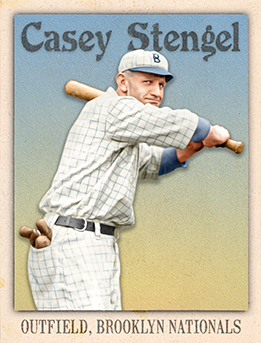
- Series: Diamond Heads '15
- City: Brooklyn
- Team: Robins
- League: National League
- Hall: National Baseball Hall of Fame
Charles Dillon Stengel (1890-1975) played and managed over half a century, seeing the game go from the Dead Ball Era to “Can’t anybody here play this game?” Casey broke in with Brooklyn in 1912, then the Pirates, Phillies, Giants and Braves, compiling a respectable .284 BA with 60 HRs. Stengel won the Giants’ two Series victories in ’23 with home runs. But it was not as a player that Casey entered the Hall of Fame. He managed his way to Cooperstown riding 1905 lifetime wins at the helm of the New York clubs and Boston from ’34-’65. He played for one world-title team and managed 7 more. The venerable and voluble manager became a fount of baseball wisdom and humor, endearing him to generations of fans.
- Only man to wear the uniforms of the 4 NY clubs
- Came out of retirement to helm the hapless Mets through their painful early years, giving the Old Perfessor “new ways to lose I never knew existed before.”
- Elected to Hall of Fame: 1966
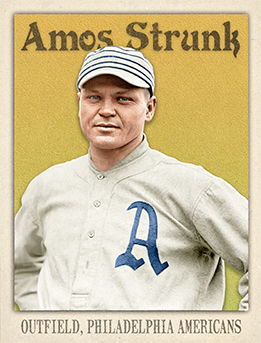
- Series: Diamond Heads '15
- City: Philadelphia
- Team: Athletics (AL)
- League: American League
Amos Aaron Strunk (1889-1979) was added to Connie Mack’s growing assemblage of speedy players in 1908 and then sent to Milwaukee to get major-league-ready. In and out with injuries (much of his career) Strunk began to shine on defense. By 1913 he was touted as the best defender of all-time. In ‘16 Baseball Magazine proclaimed him to be in the company of Cobb and Speaker. Mack witnessed Strunk’s contributions to three national championships, 1911, 1913, and 1914, read the reviews and still said Strunk was underrated. Sold to Boston when Mack was rebuilding, Amos couldn’t adjust to Beantown despite another title and returned to the Athletics in 1919. After another stint with the White Sox, Mack got his prized centerfielder back one final time in 1924 but the toll of too many outfield collisions brought an end to a 17-year career where the left-hander compiled a .284 average. Never a big base-stealer, Strunk was among the best at advancing on the basepaths. Mack’s famed “double squeeze play” owed much to Strunk’s ability to get a jump from second and score right behind the runner who had been at third when the bunt got down.
- Strunk lived to see 90, having spent over half a century in the insurance business following his retirement from the game
